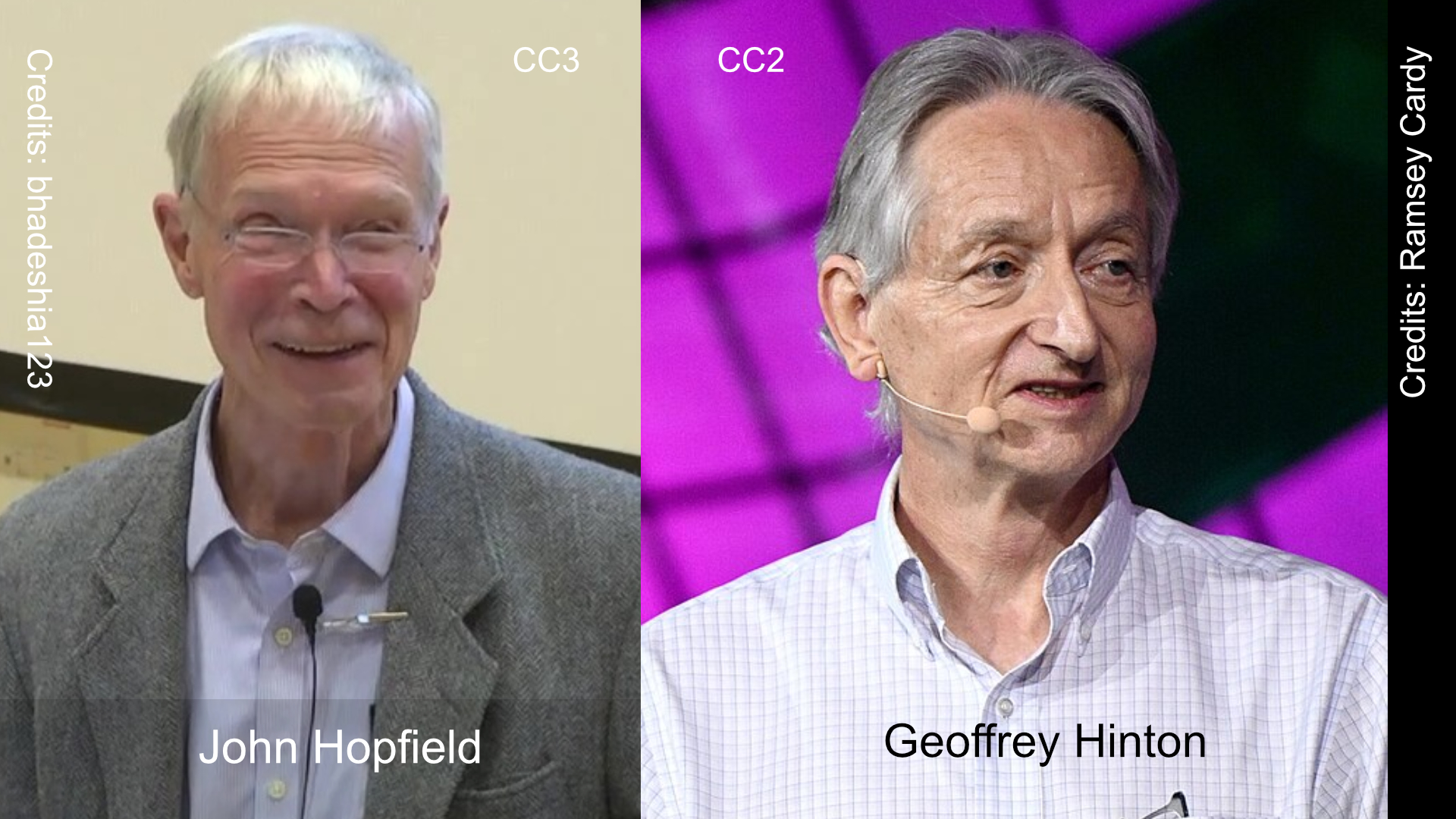Artificial neural networks are inspired by the human brain’s structure and function. These networks consist of interconnected neurons that process and interpret data, enabling machines to learn from experience. The Royal Swedish Academy of Sciences honored Hopfield and Hinton for their “foundational discoveries and inventions that enable machine learning with artificial neural networks,” recognizing the transformative impact of their research.
- The Royal Swedish Academy of Sciences recognized John Hopfield and Geoffrey Hinton for their groundbreaking work on artificial neural networks, which are inspired by the brain’s structure and learning processes.
- John Hopfield’s development of the Hopfield network applied principles from physics to neural modeling, while Geoffrey Hinton’s creation of the restricted Boltzmann machine laid the groundwork for deep learning networks.
- Their research has revolutionized AI, enabling machines to process large datasets and make accurate predictions, with applications ranging from healthcare to finance.
- The Nobel Prize acknowledges their role in advancing AI technology, which continues to influence various sectors and drive innovation in modern society.
John Hopfield, affiliated with Princeton University, developed the Hopfield network, a type of recurrent neural network that uses principles of Hebbian learning to strengthen neuron connections. His research has been instrumental in applying statistical physics methods to neural circuit modeling. Geoffrey Hinton, based at the University of Toronto, furthered these concepts by creating the restricted Boltzmann machine, which enabled the development of deep learning networks. This breakthrough has revolutionized AI, making it integral to various fields, from healthcare to finance.
Reports from the Royal Swedish Academy and other scientific organizations underscore the importance of these developments. AI’s ability to analyze vast datasets, recognize patterns, and make predictions has far-reaching implications. These technologies are not only enhancing research capabilities but are also becoming part of daily life, powering tools like facial recognition and natural language processing.
The Nobel Prize recognizes the significant contributions of Hopfield and Hinton in advancing AI technologies. Their work has laid a foundation for continued innovation, ensuring that AI remains a vital force in shaping the future of technology and society.
The Groundbreaking Work of John Hopfield and Geoffrey Hinton in Artificial Neural Networks
Artificial intelligence (AI) is no longer just a futuristic concept from science fiction—it’s rapidly becoming an integral part of modern life. From recommending products online to diagnosing diseases, AI has transformed numerous industries and revolutionized how we approach data analysis. But behind AI’s impressive capabilities lies the intricate science of artificial neural networks (ANNs), which mimic the brain’s structure and learning processes. The recent Nobel recognition of two AI pioneers, John Hopfield and Geoffrey Hinton, highlights the foundational contributions that have propelled AI into the mainstream.
The Science Behind Neural Networks
At the core of AI are artificial neural networks, which are inspired by how the human brain processes information. The human brain consists of billions of neurons, which transmit signals to each other through synapses. This interconnected network of neurons allows the brain to recognize patterns, learn from experiences, and adapt over time. Artificial neural networks aim to replicate this behavior using layers of artificial neurons, or nodes, that process data in a similar way.
Each node in a neural network receives input, processes it, and transmits the output to other nodes, gradually refining the information as it moves through the network. The key feature of neural networks is their ability to learn from data through training, much like how the brain learns from experiences. This ability to “learn” is what powers machine learning (ML), a subset of AI that allows machines to improve their performance over time without explicit programming.
John Hopfield: Laying the Groundwork with the Hopfield Network
John Hopfield, a theoretical physicist at Princeton University, played a pivotal role in the early development of artificial neural networks. In the 1980s, Hopfield introduced the Hopfield network, a type of recurrent neural network (RNN) that is characterized by its feedback loops. These loops allow data to circulate within the network, enabling it to model associative memory—a process by which the brain retrieves information based on associations.
Hopfield’s network was significant because it demonstrated how neural networks could use principles of physics, specifically statistical mechanics, to solve optimization problems and store patterns. His work also laid the groundwork for understanding how neurons could strengthen their connections based on Hebbian learning, the idea that “neurons that fire together wire together.” In this model, the strength of the connections between neurons increases when they are activated simultaneously, helping the network remember and retrieve information more efficiently.
Although the Hopfield network was relatively simple compared to today’s complex AI models, it established a framework for how neural networks could mimic the brain’s associative memory and problem-solving abilities. This breakthrough opened the door to more advanced models that could tackle real-world tasks.
Geoffrey Hinton: Advancing AI with Deep Learning
While John Hopfield focused on early neural network architecture, Geoffrey Hinton, a cognitive psychologist and computer scientist at the University of Toronto, took the concepts of AI a step further by developing the restricted Boltzmann machine (RBM). The RBM is a type of stochastic neural network that was crucial in advancing the field of deep learning, a subset of machine learning that involves using multiple layers of artificial neurons to analyze complex data patterns.
In a deep learning model, information passes through several layers of neurons, each layer extracting more intricate features from the data. Hinton’s creation of the RBM was revolutionary because it allowed these networks to learn more efficiently by reducing the complexity of the model while still preserving the essential information. His work addressed some of the limitations of earlier neural networks, particularly in tasks requiring large datasets, such as image recognition and natural language processing.
Hinton’s contributions to deep learning were instrumental in the development of convolutional neural networks (CNNs), which are used in image processing, and recurrent neural networks (RNNs), which excel in sequence-based tasks like speech recognition. These advancements enabled AI systems to perform tasks that were previously considered impossible for machines, such as recognizing faces in photos, translating languages in real-time, and even diagnosing diseases through medical imaging.
AI’s Real-World Applications
The implications of Hopfield and Hinton’s work have been profound. Today, artificial neural networks and deep learning models are at the heart of many AI systems that we interact with daily. Some key applications include:
- Healthcare: AI-powered tools can analyze medical images, predict patient outcomes, and assist doctors in diagnosing diseases. Deep learning models have been used to detect cancerous tumors in medical scans with high accuracy, significantly improving early diagnosis and treatment outcomes.
- Finance: Financial institutions use AI to detect fraudulent transactions, assess credit risk, and optimize investment strategies. Neural networks can quickly analyze massive datasets to identify patterns and make predictions, offering insights that would take humans much longer to uncover.
- Natural Language Processing (NLP): AI systems can now understand and generate human language with remarkable accuracy. Applications like virtual assistants (e.g., Siri or Alexa), chatbots, and automated customer service systems rely on deep learning models to process and respond to user input in real-time.
- Autonomous Vehicles: Self-driving cars use neural networks to interpret sensory data from cameras, radar, and LIDAR systems to navigate safely. These AI systems are capable of recognizing objects on the road, predicting the behavior of other vehicles, and making split-second decisions to avoid accidents.
- Entertainment: Streaming platforms like Netflix and Spotify use AI algorithms to recommend content to users based on their viewing or listening history. These recommendations are powered by neural networks that analyze user behavior patterns to offer personalized suggestions.
The Nobel Recognition: A Catalyst for Future Innovation
The Nobel recognition of John Hopfield and Geoffrey Hinton underscores the transformative nature of their contributions to AI. Their work has laid the foundation for innovations that continue to shape the future of technology and society. As AI systems become more advanced, we can expect even greater integration into industries such as healthcare, finance, education, and transportation.
At the same time, their achievements raise important questions about the ethical and societal implications of AI. With machines becoming more capable of performing tasks that were once the domain of humans, there is growing concern about issues like job displacement, data privacy, and the potential misuse of AI technologies.
Nevertheless, the pioneering work of Hopfield and Hinton ensures that AI will remain a driving force in technological progress. As researchers build on their discoveries, the future of AI holds immense promise in solving some of the world’s most pressing challenges, from curing diseases to addressing climate change.
In recognizing their contributions, the Nobel Prize not only honors their past achievements but also signals the critical role that AI will play in shaping the future of our world.
Conclusion
The advancements made by John Hopfield and Geoffrey Hinton in the field of artificial neural networks have revolutionized AI and its applications. By mimicking the brain’s learning processes, their models have enabled machines to analyze complex data, recognize patterns, and make predictions in ways that were previously unthinkable. Their work has opened new frontiers in industries ranging from healthcare to finance, making AI an indispensable tool in modern society. As AI continues to evolve, the foundational work of these two scientists will remain central to its ongoing development.





